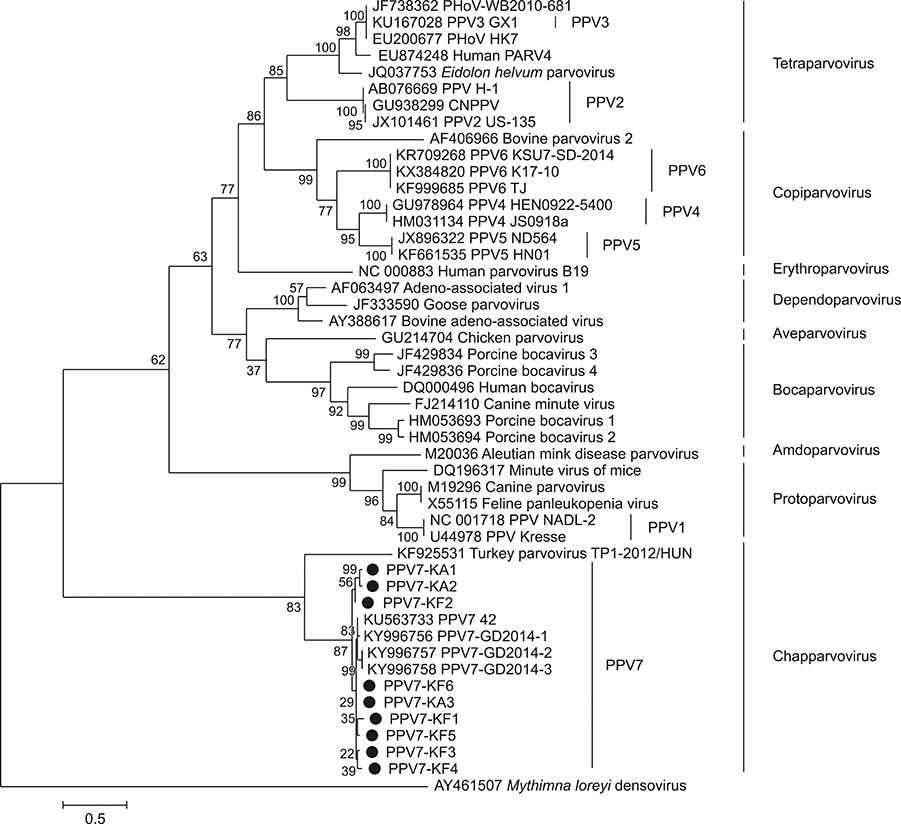J Vet Sci.
2018 Nov;19(6):855-857. 10.4142/jvs.2018.19.6.855.
First detection and genetic characterization of porcine parvovirus 7 from Korean domestic pig farms
- Affiliations
-
- 1Viral Disease Research Division, Animal and Plant Quarantine Agency, Gimcheon 39660, Korea.
- 2College of Veterinary Medicine & Animal Disease Intervention Center, Kyungpook National University, Daegu 41566, Korea. parkck@knu.ac.kr
- KMID: 2427036
- DOI: http://doi.org/10.4142/jvs.2018.19.6.855
Abstract
- Porcine parvovirus 7 (PPV7) was first detected in Korean pig farms in 2017. The detection rate of PPV7 DNA was 24.0% (30/125) in aborted pig fetuses and 74.9% (262/350) in finishing pigs, suggesting that PPV7 has circulated among Korean domestic pig farms. Phylogenetic analysis based on capsid protein amino acid sequences demonstrated that the nine isolated Korean strains (PPV-KA1-3 and PPV-KF1-6) were closely related to the previously reported USA and Chinese PPV7 strains. In addition, the Korean strains exhibit genetic diversity with both insertion and deletion mutations. This study contributes to the understanding of the molecular epidemiology of PPV7 in Korea.
Keyword
MeSH Terms
Figure
Reference
-
1. Le SQ, Gascuel O. An improved general amino acid replacement matrix. Mol Biol Evol. 2008; 25:1307–1320.
Article2. Lee JY, Kim EJ, Cho IS, Lee KK, Shin YK. Complete genome sequences of porcine parvovirus 2 isolated from swine in the Republic of Korea. Genome Announc. 2017; 5:e01738-16.
Article3. Oh WT, Kim RY, Nguyen VG, Chung HC, Park BK. Perspectives on the evolution of porcine parvovirus. Viruses. 2017; 9:pii: E196.
Article4. Palinski RM, Mitra N, Hause BM. Discovery of a novel Parvovirinae virus, porcine parvovirus 7, by metagenomic sequencing of porcine rectal swabs. Virus Genes. 2016; 52:564–567.
Article5. Streck AF, Canal CW, Truyen U. Molecular epidemiology and evolution of porcine parvoviruses. Infect Genet Evol. 2015; 36:300–306.
Article6. Tamura K, Stecher G, Peterson D, Filipski A, Kumar S. MEGA6: Molecular Evolutionary Genetics Analysis version 6.0. Mol Biol Evol. 2013; 30:2725–2729.
Article7. Xiao CT, Giménez-Lirola LG, Jiang YH, Halbur PG, Opriessnig T. Characterization of a novel porcine parvovirus tentatively designated PPV5. PLoS One. 2013; 8:e65312.
Article8. Xing X, Zhou H, Tong L, Chen Y, Sun Y, Wang H, Zhang G. First identification of porcine parvovirus 7 in China. Arch Virol. 2018; 163:209–213.
Article
- Full Text Links
- Actions
-
Cited
- CITED
-
- Close
- Share
- Similar articles
-
- Notable mutations of porcine parvovirus 1 and 4 circulating in commercial pig farms in South Korea
- Age-specific Prevalence of Porcine Reproductive and Respiratory Syndrome Virus, Porcine Circovirus Type 2, and Mycoplasma hyopneumoniae in Korea Pig Farms
- Surveillance of ASF-infected pig farms from September to October 2019 in South Korea
- Detection of hepatitis E virus genotypes 3 and 4 in pig farms in Korea
- Genetic diversity of porcine reproductive and respiratory syndrome virus in Korea


